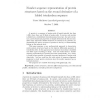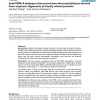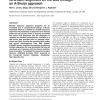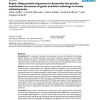393 search results - page 17 / 79 » Multiple Alignment of protein structures and sequences for V... |
CORR
2006
Springer
13 years 7 months ago
2006
Springer
A protein is a sequence of amino-acids of length typically less than 1, 000, where there are 20 kinds of amino-acids. In nature, each protein is folded into a well-defined three-d...
BMCBI
2008
13 years 7 months ago
2008
Background: Insertions and deletions (indels) represent a common type of sequence variations, which are less studied and pose many important biological questions. Recent research ...
BMCBI
2006
13 years 7 months ago
2006
Background: The residue-wise contact order (RWCO) describes the sequence separations between the residues of interest and its contacting residues in a protein sequence. It is a ne...
NAR
2006
13 years 7 months ago
2006
Multiple sequence alignment programs are an invaluable tool in computational biology. A-Bruijn Alignment (ABA) is a method for multiple sequence alignment that represents an align...
BMCBI
2008
13 years 7 months ago
2008
Background: For many types of analyses, data about gene structure and locations of non-coding regions of genes are required. Although a vast amount of genomic sequence data is ava...




